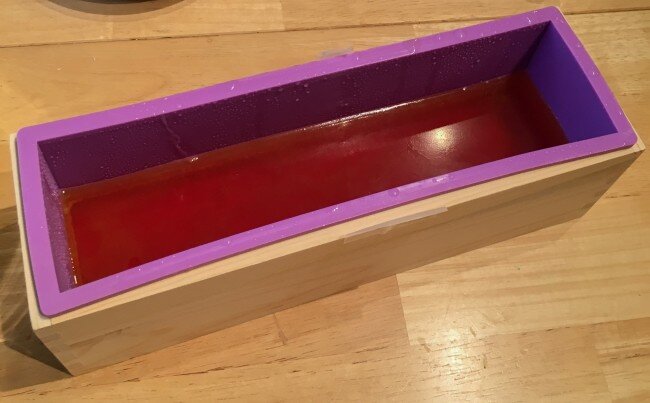7 Things I've Learned From Starting Soap Making
I've wanted to try making soap for quite awhile. About a week ago, I finally took the plunge and tried it! After making a couple of batches, I've learned a few lessons (some the hard way) and some tips about making melt and pour soap.
Watch a Video
Like with so many crafts, YouTube is your friend when it comes to learning to make soap. Melt and pour soap, while not having the complications of handling chemicals that comes with cold processed soap, can still be tricky as you try to manage temperature and its quick setting properties. Before I ever tried to make a single bar of soap, I took what amounted to an immersion class in melt and pour soap making on YouTube by binge watching some of the best soap channels available. My favorites are Soap Queen, the channel run by popular online store Brambleberry, and Ariane Arsenault, a Canadian soap maker with an online store and a small shop on a tourist island off the Atlantic coast of Quebec. Watching a good number of episodes binge style was a great way to pick up a little tips that helped me deal with problems that came up during my first batches (or avoid them altogether).
Start at Michaels
Virtually all of my first batches of supplies have been purchased at Michaels. Unless you are lucky enough to have a soap making specialty store in your neighborhood, Michaels is a great place to start for supplies for making your first batches of melt and pour soap. They are well known in the soaping community for having an affordable selection of good melt and pour soaping basics: soap base, fragrance, colors, and molds. Michaels offers soap base in a good variety of options to experiment with, like Glycerin, Shea Butter, Goats Milk, Honey Glycerin, and Olive Oil. The different bases come in 2 pound packs, a great amount for playing with, but a few come in 5 pound packs. And for mega soapers there's even a 10 pound bucket of glycerin. I've not seen the soaping items on sale regularly that I can recall, but with a coupon the items are very affordable.
Once I've exhausted the options at Michaels, I plan to make an order soon from Brambleberry to get some wider options of molds, soaps, and additives to try out.
Good Equipment Makes A Difference
It can seem premature to go out and invest in special equipment when trying a new craft. But having the right equipment - especially a few key items - can make all the difference in your melt and pour soap making success.
Pyrex containers are a must for heating melt and pour soap (although I do see other soap makers doing it in other types of containers). A bowl will work but I recommend getting something like this 8 cup measuring cup that I use, because it has a pour spout that reduces the risk of messes (and burns) when pouring hot soap. This Pyrex measuring cup has quickly become my work horse while soaping. It's safe, holds heat well, and is easy to clean.
Since most soaping recipes are done by weight, you'll also need a good kitchen scale with a tare function that can do weight in both grams and ounces.
If you want to create in any quantity, or experiment with techniques like swirls or embeds, you'll want a loaf mold. A small loaf mold is a good way to start so that your experiments don't lead to too much ruined soap or frustration. I have been using this loaf mold with a silicone liner from Amazon. It is the perfect size, just slightly larger than a typical guest or travel soap, and the liner is easy to remove and unmold.
And last but not least, is a decent infrared thermometer like the one I got from Amazon. Temperature is important when doing melt and pour soap, and even more important when doing certain layering and other decorative techniques. It can mean the difference between success and a major oops. Infrared thermometers are instant, which is especially good since often you need to know the temperature fast when working with quick setting melt and pour. Also, since the infrared thermometer can register a temperature without touching the soap, there's much less clean-up to worry about (and one less dirty tool dripping soap around your work space).
Raid the Pantry
A lot of the things that will make soap making successful and fun you'll find in your own pantry. Some of the easiest (and most wonderful) soap additives to work with are probably already hiding in your kitchen cupboards: oatmeal, honey, coffee, and olive oil. Any of those can be added to a simple soap base to create a soap that is stepped up a notch.
It's not just ingredients you'll find in your cupboards, but tools and supplies as well. You may have already raided the kitchen for your measuring cups or Pyrex bowls but there's plenty more useful items in those cupboards. Cling wrap (shrunk with a heat gun) is a great way to wrap soap. Disposable food storage containers like ones made by Ziplock are great for storing ingredients and finished soap. Spatulas are great for stirring soap to help it melt (or stay melted) and to mix in colors or fragrance. A dough scraper can be hijacked to serve as a soap cutter, and of course you'll need a cutting board to use it on.
Soap Making Mistakes Melt Away
The great thing about using melt and pour soap base is that there really are no mistakes - or at least ones that are permanent. Most "mistakes" can be either remelted and poured again, or chopped up into embeds to use for another pour.(The rare exception to this would be burning the soap or something like that.) So you can melt and pour away with little fear of catastrophe! My first melt and pour mistake - a failed swirl technique that blended into a solid color - was partially chopped up and became embeds for my first try at an embedding technique.
Get Some Alcohol
Alcohol works wonders for soap...rubbing alcohol, that is. Get some 90% rubbing alcohol (I found mine at Walmart) and put it in a small spritz bottle. Sprayed liberally on top of just-poured soap, or between layers, it will help to pop air bubbles and adhere layers together. Watch any of the video channels I linked above and you'll see the soapers using the alcohol, but it really has to be seen with your own eyes to understand the miracles it works at finishing off your soap's surface beautifully.
Freeze It To Free It
Many sources recommend spraying your molds (especially the plastic ones) with something like Pam to grease them so that the soap will come out easily when it is done. However, if you forget (like I did), I'm here to tell you what I discovered. The first time that I made my soap in my decorative plastic molds, I tried to remove it from the molds and it was stuck. Hard. No way that soap was going anywhere. A few frantic internet searches later I learned that I could probably freeze it free. A couple of minutes in the freezer and the soap is supposed to shrink enough to come easily out of the mold. It worked beautifully! However, don't leave the soap in too long (like I did on a later use of the same method) or your soap will end up sweating and damp. Two minutes or a bit more in the freezer may be all your soap needs to chill its way out of the mold.
There's something of a learning curve but with proper preparation beforehand I was able to make very respectable soap my first try. It is very satisfying seeing the results of my work laid out en masse on the table after being cut. It feels so productive!
Have you tried soap making? What advice do you have for a new soap maker? What do you wish you knew when you started out?





